The U.S Territory of Guam
Guam has been a valued and important part of the United States since 1898 when it was ceded by Spain to the United States, along with the Philippines and Cuba, by the Treaty of Paris ending the Spanish-American War. Except for the Japanese invasion and occupation, 1941 through 1944, Guam has remained part of the United States from 1898 to the present. In 1949, under pressure from the Guam Assembly for more autonomy, President Harry S. Truman signed an Executive Order transferring administration of Guam from the Navy to the Department of the Interior and directing the Department of the Interior to initiate action for transfer of administrative authority to a civil Government. In 1951, The U.S. Congress passed the Organic establishing Guam as an Unincorporated Territory with a locally elected Governor, Lieutenant Governor, Senate and local village governance.
The United States formally purchased Guam from Spain for $20 million in 1899. At the time of the turnover, the local population of Guam had grown to about 10,000 inhabitants. U.S. President William McKinley issued an executive order placing Guam within the administration of the Department of Navy. Capt R. P. Leary was appointed the island’s first U.S. Governor. Under Navy administration, Guam experienced many improvements in the areas of agriculture, public health, sanitation, education, land management, taxes, and public works.
Orders issued by Capt Leary on August 16,1899: regulated the importation and sale of intoxicating liquors; prohibited the transfer of land without the consent of the government; regulated the celebration of church and other holidays; prohibited concubine and required that marriage rites be performed between persons who were cohabitating; prohibited exportation of certain articles in common use; required persons without a trade or regular employment to plant specified commodities and keep certain live stock; regulated the keeping of dogs and other animals running at large; abrogated the Spanish system of taxation and provided a new one; established a public system of nonsectarian education; and required each adult to learn to write his or her own name within a specified time.
When the United States Navy commissioned the gunboat USS Guam in May 1927 to perform river patrol duty in China, it caused quite a bit of excitement on the island. The people of Guam, including schoolchildren who donated a penny each, collected $703.92 to have a ship’s bell and commemorative plaque manufactured in Shanghai, China. The bell was presented to the Navy and served with distinction on each of the three USS Guam Naval vessels, USS Guam PG-43 (1929-1941), USS Guam CB-2 (comissioned 1943) and USS Guam LPH-9. The bell disappeared during the war, but resurfaced in 1954 in the Guam Marine Barracks. It was presented to the Navy in 1985 for duty on the newest USS Guam amphibious assault ship LPH-9. The bell was returned to Guam on decommissioning of the USS Guam LPH-9 on August 25, 1998 and is now in the Guam Museum.
World War in the Pacific
Japanese Occupation of Guam (1941 – 1944)
On December 10, 1941, Guam surrendered to the Japanese South Seas detachment forces after a valiant defensive struggle by the island’s Insular Force Guard and a limited number of U.S. marines. The Japanese occupation of Guam, had begun. Guam became the only populated U.S. soil to be occupied by another country in World War II. Guam was renamed “Omiya Jima” and for 31 months, the people of Guam were forcibly subjected to intolerable hardships administered by the Japanese military.
Although some measure of religious practice and business activities were permitted, forced labor, rapes and other atrocities were common. Concentration camps were established by the 29th Division of Japan’s Kwantung Army and approximately 600 Chamorro’s were executed. Some Chamorro’s were beheaded when the Japanese learned of the 3-year humanitarian effort by Chamorro’s to successfully feed and hide U.S. Navy radioman George Tweed who escaped in the initial invasion. Tweed’s cave is a popular “boonie stomping” destination on Guam today. Many landmarks of the Japanese occupation, including coastal defense guns in Piti and other locations and other war artifacts are still evident on Guam today.
Liberation (1944)
The campaign for the liberation of Guam was marked by record tonnage of naval bombardment in which thousands of Japanese and Chamorro’s lost their lives and the city of Hagatna was nearly destroyed. American forces landed on July 21, 1944 at Asan and Agat beaches. 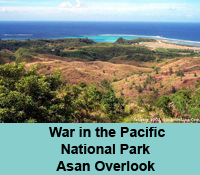 In honor of the bravery and sacrifices of all those who participated in the Pacific Theater of World War II, including soldiers, sailors and marines of the United States, Japan, Australia, Canada, China, France, Great Britain, New Zealand, the Netherlands, and the Soviet Union the landing area has been designated as the “War in the Pacific National Historic Park“. During the following bitter three-week campaign, 7,000 U.S. and 11,000 Japanese lives were lost before Guam was reclaimed and once again under American administration. Due to its strategic position, Guam was used as a command post for U.S. Western Pacific operations until the War concluded in 1945. On May 30, 1946, the U.S. Naval Government was re-established.
In honor of the bravery and sacrifices of all those who participated in the Pacific Theater of World War II, including soldiers, sailors and marines of the United States, Japan, Australia, Canada, China, France, Great Britain, New Zealand, the Netherlands, and the Soviet Union the landing area has been designated as the “War in the Pacific National Historic Park“. During the following bitter three-week campaign, 7,000 U.S. and 11,000 Japanese lives were lost before Guam was reclaimed and once again under American administration. Due to its strategic position, Guam was used as a command post for U.S. Western Pacific operations until the War concluded in 1945. On May 30, 1946, the U.S. Naval Government was re-established.
Although concluded over 70 years ago, Word War II still exerts a major influence on Guam. Relics and evidence of the War are still evident all across the island. Divers can survey wrecks of Japanese, American, German and other ships and airplanes under Guam‘s warm clear waters. Japanese coastal artillery still stand in the Guam jungles. On January 24, 1972, the war finally ended for the last soldier when Japanese World War II holdout, Sergeant Shoichi Yokoi, was discovered in the cave in which he been hiding since his unit was scattered by the advancing Americans in July 1944. Today, July 21st, Guam Liberation Day, is a major Guam holiday. All Government offices and most businesses are closed as the island celebrates with day long fiestas and a parade down Marine Corps Drive in Hatagna. Sergeant Yokoi’s cave at Talafofo falls has been preserved as a popular attraction for visitors.
The US Territory of Guam Today
As the Westernmost U.S. terra firma in the Pacific, the U.S. Territory of Guam today is an important commercial and communications hub between the United States and Asia and a strategic military outpost. In 1949, U.S. President Harry S. Truman signed an Executive Order transferring the administration of Guam from the Navy to the Department of Interior. In August, 1951, the U.S. Congress passed the Organic Act making Guam an unincorporated territory of the United States with limited self-governing authority and granting US Citizenship to the people of Guam. The Government of Guam has an elected Governor, Lieutenant Governor, Senate, local village administrations and an independent income tax system. All residents of Guam at the time of the Organic Act and all persons born on Guam are US Citizens. Guam uses US currency, US banking institutions, US Customs and Immigration and US Postal Service.
In 1962, security clearance requirements for travel to Guam, which had been in place since World War II, were lifted permitting Guam’s economy to flourish and opening and influx of new residents of diverse nationalities and races such as Filipino, Japanese, Korean, Chinese, Indian, Australian, Pacific Islanders, Europeans and mainland US transplants. Guam today is a truly cosmopolitan community with a unique culture, the core of which is the ancient Chamorro heavily influenced by the Spanish occupation and the Catholic Church. Strong American influence is also evident in the celebration of many public holidays, the form of Government and the pride in being U.S. that is displayed by the populace. Guam ‘s culture has also been influenced and enriched by the Filipino, Japanese, Korean, Chinese and Micronesian immigrants each group of whom have added their unique contributions. The present population of Guam, 2006, is approximately 171,000 of whom roughly 37% are Chamorro, 26% Filipino, 11% other Pacific Islander with the remaining 26% primarily Caucasian, Chinese, Korean and Japanese, all of whom bring their cultural heritage and customs and contribute to Guam’s unique culture and appeal.
Strong American influence is also evident in the celebration of many public holidays, the form of Government and the pride in being U.S. that is displayed by the populace. Guam ‘s culture has also been influenced and enriched by the Filipino, Japanese, Korean, Chinese and Micronesian immigrants each group of whom have added their unique contributions. The present population of Guam, 2006, is approximately 171,000 of whom roughly 37% are Chamorro, 26% Filipino, 11% other Pacific Islander with the remaining 26% primarily Caucasian, Chinese, Korean and Japanese, all of whom bring their cultural heritage and customs and contribute to Guam’s unique culture and appeal.
Chamorro – Core of Guam Culture
The culture of Guam has been heavily influenced over centuries by the influx of peoples and cultures from all over the World. However the overriding culture that gives Guam it’s unique flavor is that of it’s native inhabitants, the Chamorro. The Chamorro culture is characterized by a complex social protocol centered upon respect, caring, accepting and helping one another.Inafa’maolek, or interdependence, is a central value which depends on a spirit of cooperation. 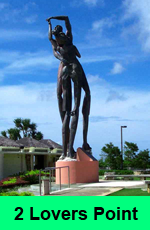 Historian Lawrence Cunningham in 1992 wrote, “In a Chamorro sense, the land and its produce belong to everyone. This is the armature, or core, that everything in Chamorro culture revolves around. It is a powerful concern for mutuality rather than individualism and private property rights.” The culture is visibly manifested in the kissing of the hands of elders, passing of legends, music, dance, chants, courtship rituals, handicrafts, burial rituals, preparation of herbal medicines, and requesting forgiveness from spiritual ancestors when entering a jungle. Glimpses of Guam culture are evident in local legends and folklore such as taotaomona (ancient spirits), Puntan Dos Amantes, the story of doomed lovers who leapt to their death off Two Lovers’ Point and Sirena, the story of a beautiful young girl who becomes a mermaid.
Historian Lawrence Cunningham in 1992 wrote, “In a Chamorro sense, the land and its produce belong to everyone. This is the armature, or core, that everything in Chamorro culture revolves around. It is a powerful concern for mutuality rather than individualism and private property rights.” The culture is visibly manifested in the kissing of the hands of elders, passing of legends, music, dance, chants, courtship rituals, handicrafts, burial rituals, preparation of herbal medicines, and requesting forgiveness from spiritual ancestors when entering a jungle. Glimpses of Guam culture are evident in local legends and folklore such as taotaomona (ancient spirits), Puntan Dos Amantes, the story of doomed lovers who leapt to their death off Two Lovers’ Point and Sirena, the story of a beautiful young girl who becomes a mermaid.
Spanish Influence Today
Over 333 years of Spanish occupation and intrusion into all aspects of Guam life has left an enduring influence on Guam life and culture that continues to this day. The Spanish occupation was characterized by conquest and conversion to “save the heathen souls”, implemented by force, which nearly resulted in the total extermination of the pure Chamorro race. Although the Spanish influence is great, the Chamorro culture remains the main influence on Guam today. The Spanish failed to recognize that the Chamorro culture was matrilineal and largely ignored the influence of the Chamorro women, which likely accounts for the fact that Chamorro culture has endured as the prominent culture on Guam to this day. The Catholic Church, brought to Guam by the Jesuits in 1668, continues to be a major influence Guam life. In 2021, Catholicism makes up approximately 75% of Guam’s religions. Protestants account for approximately 17.7%, Buddhism 1.1% Buddhism, other reliions 4.5% and 1.7% unaffiliated.
Spanish influence is evident in much of Guam’s present day architecture, especially in the Southern Villages. The Merizo Bell Tower, constructed in 1910 to alert village residents of important activities, displays a heavy Spanish architecture flavor. The Umatic Bridge, built in 1986 as the gateway to Umatic where Magellan landing in 1521, replicates Spanish Architecture of the era. A statue of Pope John Paul II rotates in the center of the capital city of Hagatna 24 hours a day on the site where he held mass in 1981. Today, every village has its patron saint whose feast day is celebrated with an elaborate fiesta to which the entire island is invited. Extended families contribute food and work to cook for the village guests.
The U.S. Military plays an important role in the present day U.S. Territory of Guam. As the Westernmost patch of U.S. soil in the Western Pacific, Guam is key to the U.S. Asian pivot as a military and commercial gateway to the Far East. Of historical significance, the last combat mission of WWII began on August 14, 1945, when 143 B-29 Super Fortress aircraft flew out of Guam on the Last Mission over Tokyo. The Arc Light memorial at Anderson AFB memorializes the massive relocation of B52 bombers to Guam in 1972 at the resumption of bombing of North Viet Nam. Today, Guam hosts major U.S. Navy and Air Force bases on Guam and plans are progressing to relocate over 5,000 U.S. Marines, support staff and dependents, from Okinawa, Japan to Guam. Guam is overall a very patriotic island, military personnel are generally welcome. Over the years, Guam has sacrificed a much greater per-capita ratio of sons and daughters to the defense of the Country that most other States. The military continues to contribute to and influence life on Guam.
| Ancient Guam through the Spanish Era |
* | US Territory and Japanese Occupation |
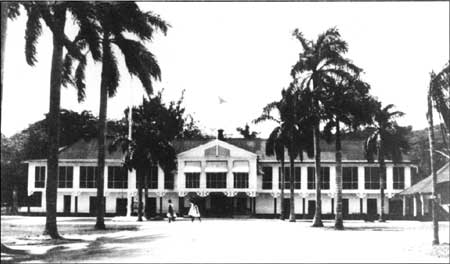 U.S. Navy Guam
U.S. Navy Guam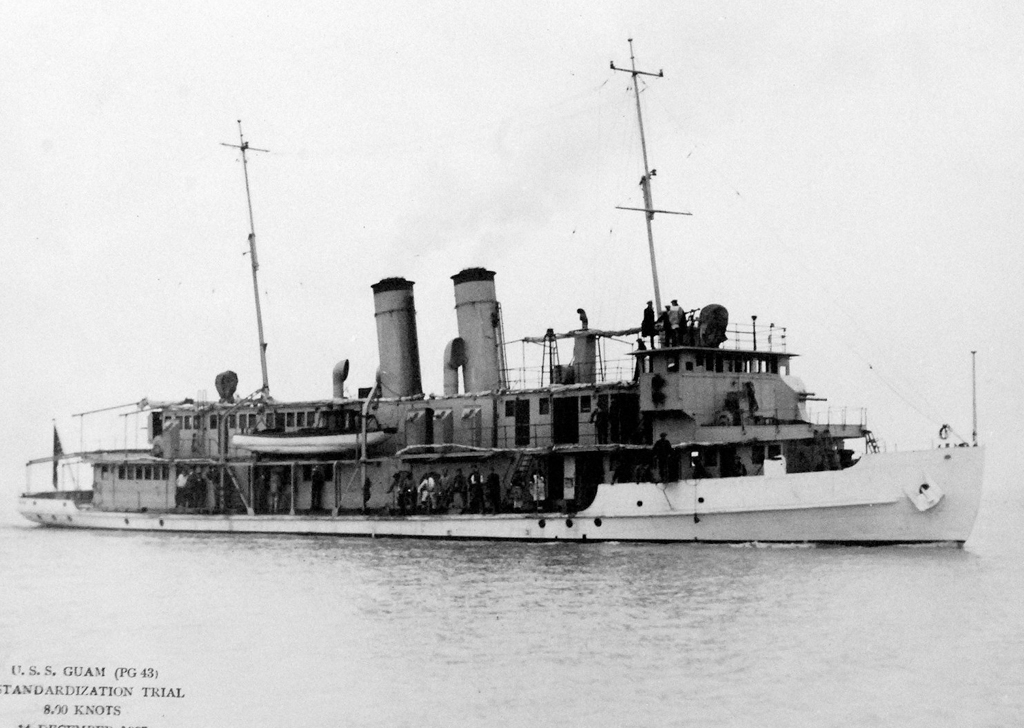 USS Guam PG-43
USS Guam PG-43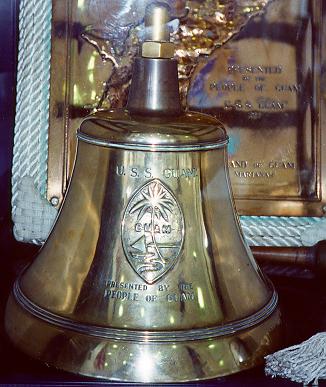 Guam Ship’s Bell
Guam Ship’s Bell Japanese WWII
Japanese WWII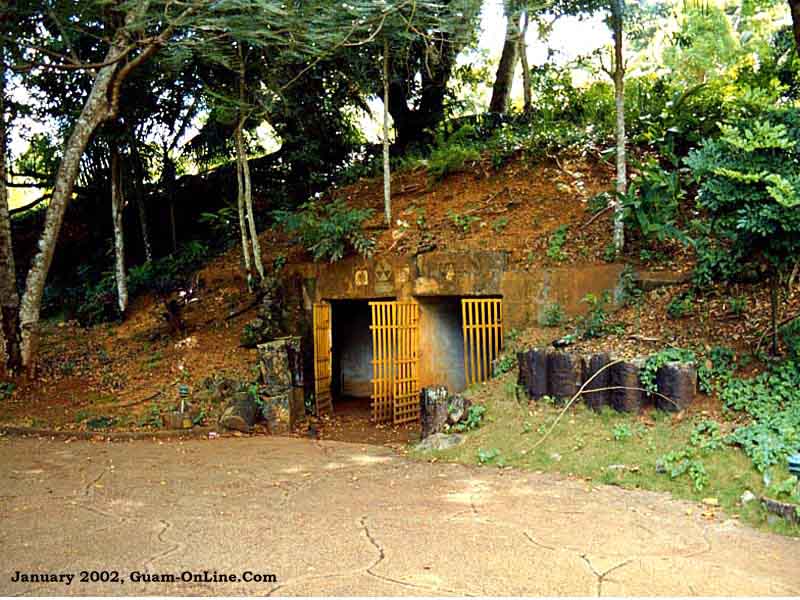 Japanese Ammunition Storage Caves
Japanese Ammunition Storage Caves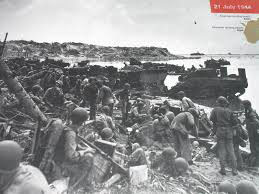 Asan Beach Landing
Asan Beach Landing GuamLiberation Day Parade
GuamLiberation Day Parade Welcome to Guam
Welcome to Guam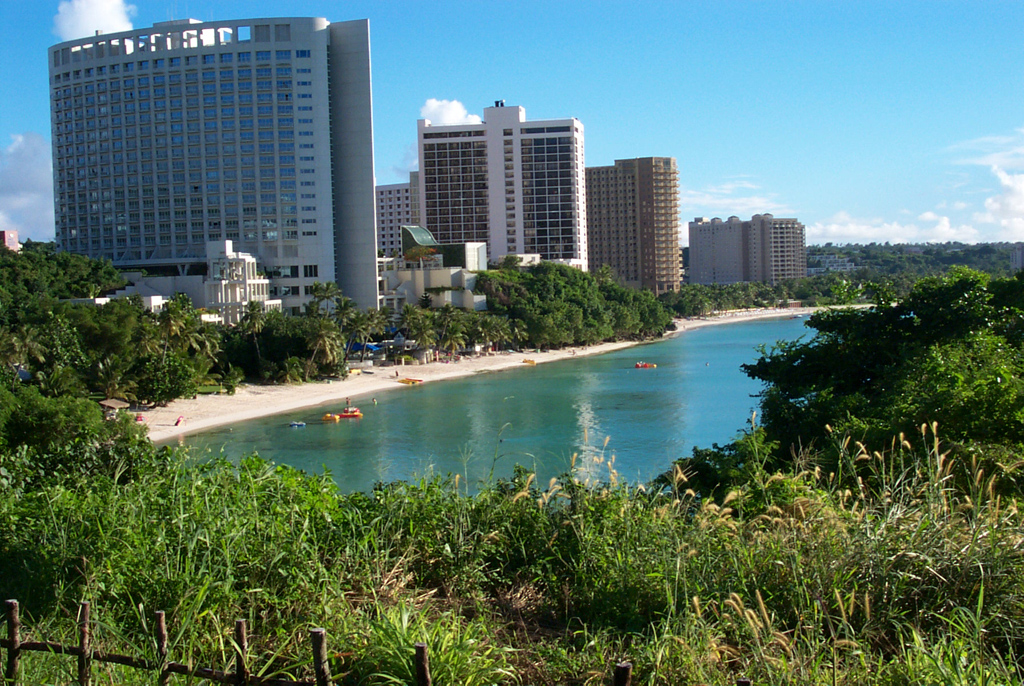 Hotel Row
Hotel Row Chamoro Cultural Dancers
Chamoro Cultural Dancers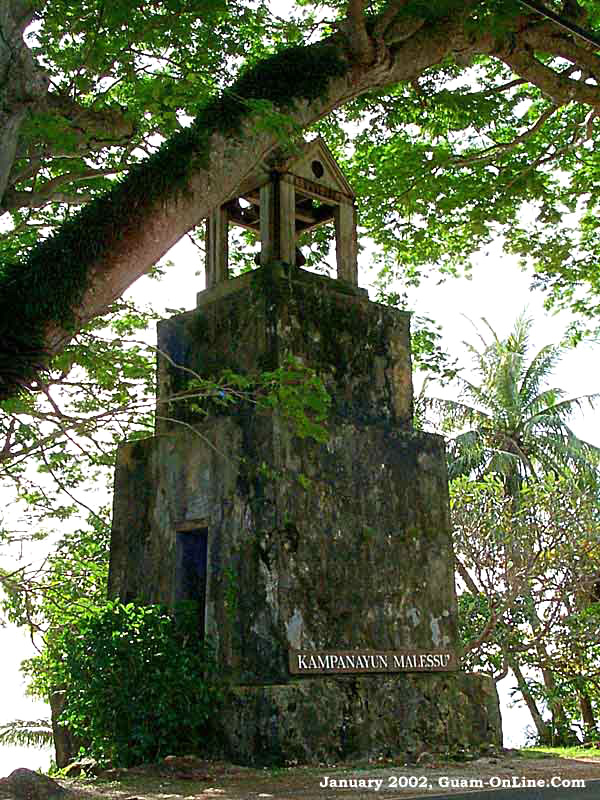 Merizo Bell Tower
Merizo Bell Tower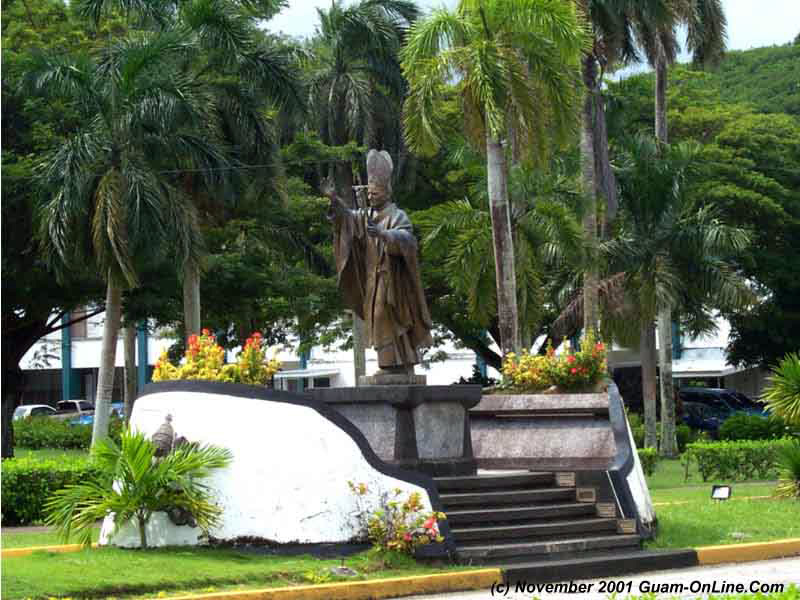 Santo Papa Statue
Santo Papa Statue Arclight Memorial
Arclight Memorial